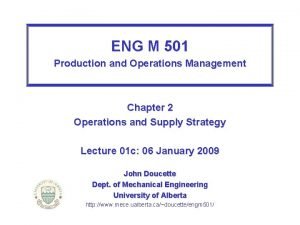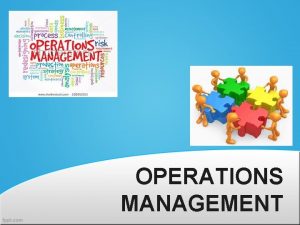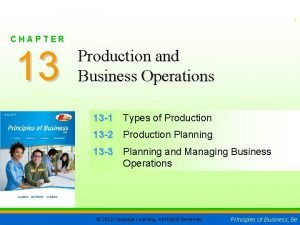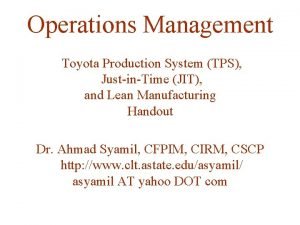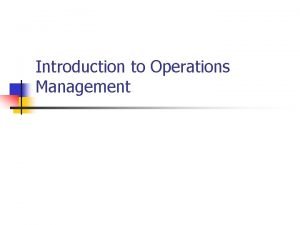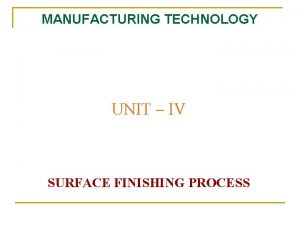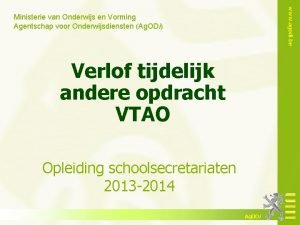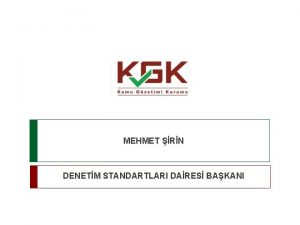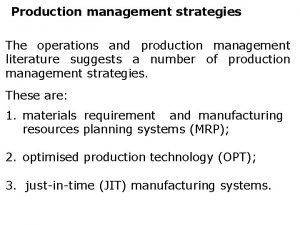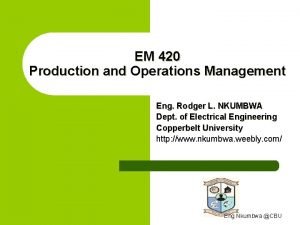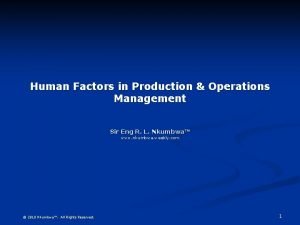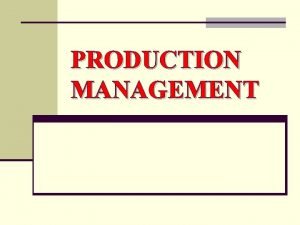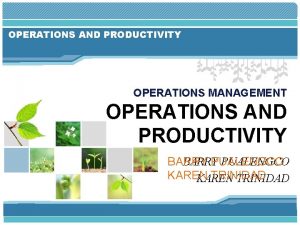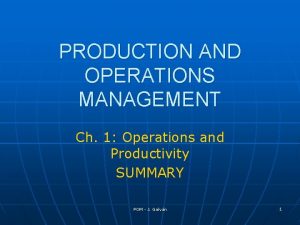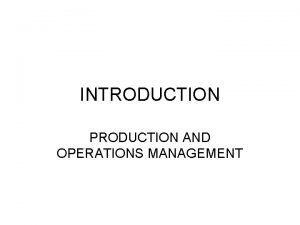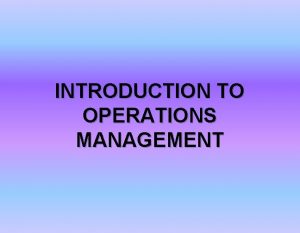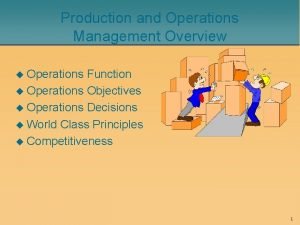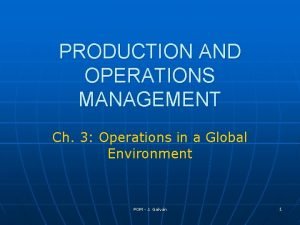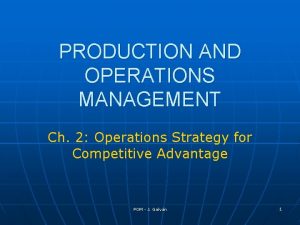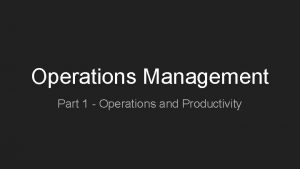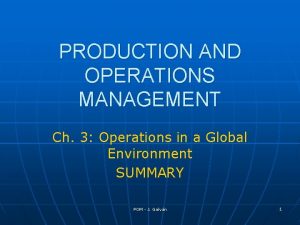ENG M 501 Production and Operations Management Chapter















- Slides: 15

ENG M 501 Production and Operations Management Chapter 2 Operations and Supply Strategy Lecture 01 c: 06 January 2009 John Doucette Dept. of Mechanical Engineering University of Alberta http: //www. mece. ualberta. ca/~doucette/engm 501/

ENG M 501– Production and Operations Management Operations Strategy • Operations strategy describes how an organization intends to create and sustain value for its shareholders. • Three main components: – operations effectiveness – customer management – product innovation 2 John Doucette Dept. of Mechanical Engineering Lecture 01 c, Chapter 2: 06 January 2009

ENG M 501– Production and Operations Management Sources of Competitiveness • Cost or Price – Make the Product or Deliver the Service Cheap • Quality – Make a Great Product or Deliver a Great Service • Delivery Speed – Make the Product or Deliver the Service Quickly • Delivery Reliability – Deliver It When Promised • Coping with Changes in Demand – Change Its Volume • Flexibility and New Product Introduction Speed – Change It • Product-Specific Criteria – Support It 3 John Doucette Dept. of Mechanical Engineering Lecture 01 c, Chapter 2: 06 January 2009

ENG M 501– Production and Operations Management Operational Trade-Offs • An organization cannot excel simultaneously on all competitive dimensions. – Speed of delivery is not compatible with flexibility. – Flexibility is not compatible with low cost. – Low cost is not compatible with high quality. • Straddling is when a firm tries to match the benefits of a successful position while maintaining its existing position. • The plant-within-a-plant (PWP) concept allows organization to excel simultaneously on multiple competitive dimensions. 4 John Doucette Dept. of Mechanical Engineering Lecture 01 c, Chapter 2: 06 January 2009

ENG M 501– Production and Operations Management Order Qualifiers and Order Winners • Order qualifiers are the basic criteria that permit the firms products to be considered as candidates for purchase by customers • Order winners are the criteria that differentiates the products and services of one firm from another • Basic product strategy steps: – Segment the market according to the product group – Identify product requirements, demand patterns, and profit margins of each group – Determine order qualifiers and order winners for each group – Convert order winners into specific performance requirements 5 John Doucette Dept. of Mechanical Engineering Lecture 01 c, Chapter 2: 06 January 2009

ENG M 501– Production and Operations Management Strategy Design Process • Four key concepts in an overall corporate strategy Financial Perspective Shareholder Value Customer Perspective Customer Value Internal Perspective Processes and Activities Learning and Growth Perspective Motivated and Prepared Workforce 6 John Doucette Dept. of Mechanical Engineering Lecture 01 c, Chapter 2: 06 January 2009

ENG M 501– Production and Operations Management Strategy Design Process (2) • The financial perspective focuses on increasing shareholder value through growth and productivity. – Revenue growth strategy • Build the franchise • Increase customer value – Productivity strategy • Improve cost structure • Improve asset utilization • The customer perspective defines how growth is achieved and is how a company differentiates itself – Product leadership – Customer Intimacy – Operational excellence 7 John Doucette Dept. of Mechanical Engineering Lecture 01 c, Chapter 2: 06 January 2009

ENG M 501– Production and Operations Management Strategy Design Process (3) • The internal perspective defines business practices and specifies activities needed to meet customer perspective – – Product leadership Customer intimacy Operational excellence Regulatory and environmental excellence • The learning and growth perspective defines intangible assets – Strategic competencies – Strategic technologies – Climate for action 8 John Doucette Dept. of Mechanical Engineering Lecture 01 c, Chapter 2: 06 January 2009

ENG M 501– Production and Operations Management Service Strategy Capabilities • Process-based – Capabilities that transforms material or information – Provide advantages on dimensions of cost and quality • Systems-based – Capabilities that are broad-based – Provide advantages of short lead times and customize on demand • Organization-based – Capabilities that are difficult to replicate – Provide abilities to master new technologies 9 John Doucette Dept. of Mechanical Engineering Lecture 01 c, Chapter 2: 06 January 2009

ENG M 501– Production and Operations Management Productivity • Productivity is a common measure on how well resources are being used. – The relationship between the output produced by a given system during a given period of time and the quantity of resources consumed to create the output. • To increase a firm’s productivity: – – increase output decrease input increase output faster than input decreased input faster than output. 10 John Doucette Dept. of Mechanical Engineering Lecture 01 c, Chapter 2: 06 January 2009

ENG M 501– Production and Operations Management Productivity (2) • Partial factor productivity is the ratio of output to one type of input: – – Labour productivity Capital productivity Energy productivity Materials productivity • Multifactor productivity uses more than a single input: – labour + capital – capital + materials – Etc. • Total factor productivity uses all the inputs: – labour + capital + material + energy 11 John Doucette Dept. of Mechanical Engineering Lecture 01 c, Chapter 2: 06 January 2009

ENG M 501– Production and Operations Management Productivity (3) • Usually desirable to use measures that represent productivity as it relates to some output of interest. • Example: This week your employees used a total of 2400 hours of labour to process 560 insurance forms. Last week the same crew used only 2000 hours of labour to process 480 forms. – Last week’s productivity = 480/2000 = 0. 24. – This week’s productivity is = 560/2400 = 0. 23. – So, productivity is decreasing slightly. 12 John Doucette Dept. of Mechanical Engineering Lecture 01 c, Chapter 2: 06 January 2009

ENG M 501– Production and Operations Management Productivity Example #1 • Consider the following input and output data which were collected from a production system. • Compute labour, material, energy, capital, and total productivity. 13 John Doucette Dept. of Mechanical Engineering Lecture 01 c, Chapter 2: 06 January 2009

ENG M 501– Production and Operations Management Productivity Example #2 1. Determine productivity for the following cases: a) Four workers installed 720 square metres of carpeting in 8 hours b) A machine produces 68 pieces of your product in 2 hours 2. Determine multi-factor productivity for labour and machine use if: – Labour costs were $1000, material costs were $500, and overhead costs were $2000 – You produced 7000 units worth $2 per unit 14 John Doucette Dept. of Mechanical Engineering Lecture 01 c, Chapter 2: 06 January 2009

ENG M 501– Production and Operations Management Improving Productivity • • Develop productivity measures Look carefully at systems as a whole Establish reasonable goals Develop methods and goals to achieve improvements Management support Measure and publicize Use technology and capital as appropriate 15 John Doucette Dept. of Mechanical Engineering Lecture 01 c, Chapter 2: 06 January 2009
 Eng m 501
Eng m 501 Funksiyaning eng katta va eng kichik qiymati
Funksiyaning eng katta va eng kichik qiymati Contoh pre production
Contoh pre production Examples of operation management
Examples of operation management Chapter 13 production and business operations
Chapter 13 production and business operations Takt time toyota production system
Takt time toyota production system Types of process selection
Types of process selection Chapter 12 inventory management
Chapter 12 inventory management Production operations definition
Production operations definition Surface finishing operations in production technology
Surface finishing operations in production technology Quality management in operations management
Quality management in operations management What is tqm
What is tqm Barema 501 onderwijs
Barema 501 onderwijs Arabské číslice
Arabské číslice Bds 501
Bds 501 Somos um pequeno povo mui feliz
Somos um pequeno povo mui feliz
